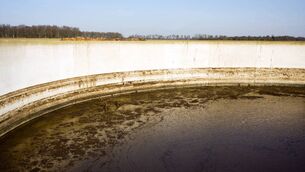Herd Management: The secret to keeping cows performing in late lactation

Late lactation will determine your profit each year, writes ruminant nutritionist Brian Reidy.
As we head deep into October, the usual occurs with grass quality, grazing condition and the weather deteriorate, resulting in poorer intakes and lower performance in both dairy and beef herds.
Many dairy herds are experiencing a significant drop off in milk yield and every reason is being offered up for this. In reality, one issue is causing it, and that is simply a significant decrease in total dry matter and energy intake.
At no stage during lactation should dramatic tail-offs in performance be accepted, so why accept it with 10 to 15% plus of the lactation remaining?
Autumn grass will always have low fibre and dry matter contents, with high proteins, which can cause increased passage rates in the rumen, resulting in underutilisation of grass.
These shortcomings must be addressed if you want to keep cows performing as well as they should be.
A natural lactation curve should see cows dropping by 1.5 to 2% per week or 6 to 8% per month. How does your herd measure up compared to this?
Are your fat and protein percentages increasing accordingly to reflect the drop-off in yield?
If solid percentages are not increasing as volume drops, then cows are not getting sufficient fibre and/or sufficient energy.
The introduction of grass silage can depress protein, in particular, if care is not taken to balance the silage correctly. Convert your milk yield to Kg of milk solids so that you can see how cows are performing on a day-to-day and week-to-week basis.
Allocating grass efficiently, appreciating the dry matter of your swards and aiming to keep grass in the cow’s diet for as long as is practical for your farm will help you to optimise profitability in late lactation.
With grass currently at 12-14% Dry Matter, there is less grass in the same fresh weight compared to those grazed in August and early September.
For example, if we take a dairy cow requiring a total dry matter of 17-18kg/day, if she gets 4kg of meal in the parlour or through a mixed ration, then she needs to eat the balance from grass if out fulltime, meaning she must eat well over 100kg of fresh grass.
Again, this is not possible in the current conditions and time of year/stage of lactation. If housed by night and offered 6-7kg of dry matter, then the required dry matter over 24 hours can be achieved while grazing by day.
Anyone with health monitoring systems may have access to intake and rumination statistics for their herd, and no matter how much grass you offer them at night, they don’t actively eat for many minutes once it gets dark. Basically, the cows are telling you that they are better off in by night at this point in the year.
A natural lactation curve should see cows dropping by 1.5 to 2% per week or 6 to 8% per month. How does your herd measure up compared to this? Are your Fat and Protein percentages increasing accordingly to reflect the drop off in yield?
If solid percentages are not increasing as volume drops, then cows are not getting sufficient fibre and/or sufficient energy.
The introduction of grass silage can depress protein, in particular, if care is not taken to balance the silage correctly. Convert your milk yield to kilo of milk solids so that you can see how cows are performing on a day-to-day and week-to-week basis.
What also must be considered is that youngstock feed intakes are also plummeting. If we do some simple maths based on dry matter intakes for a 250 kg heifer intended for breeding next spring.
She must consume 5kg of dry matter in order to achieve 0.7/0.8 kgs of growth/weight gain per day. If grass is 13% dry matter she needs to eat over 38kg of fresh grass.
This is not possible, therefore, she needs supplementation to continue to hit growth targets. These heifers are best housed if feeding them outside is not possible.
The late lactation cow no longer needs to be fed in line with quota management as was traditionally the case. Therefore, a long dry period is unnecessary, unwise and very costly.
Milk solids and milk yield, along with grass supply, silage quality and body condition, should determine the nutrition management required at this time of year.
This should involve a cost-effective balanced diet that supplies ingredients which are deficient in autumn grass. It should have a high energy content and effective fibre to provide structure in the rumen, and the aim must be to complement the grass available. Maintaining performance and an appropriate body condition must be the focus.
A cow getting 4 or 5kg of meal that is milking at present will only be eating this on top of the silage that she would be eating if she was dry anyway. Therefore, a cow will only need to produce approximately seven litres to return a margin.
If cows are in good condition, keep them milking. Many top herds across Europe and beyond only have cows dry for 35 to 42 days. It has been a hard year, don’t cut off a revenue stream too early!












